Watertight Door
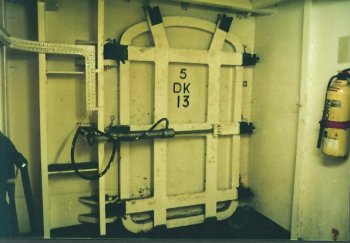 |
| watertight door |
Watertight doors are doors which
are designed to keep water out. These doors are design to
maintain the ships stability should it be involved in a
unfortunate
accident. Certain rules and regulations
adopted by the IMO require ships to be able to survive
such a tragic event. For example a ferry carrying
passengers needs to be able to withstand a flooding of
two of it's compartments.
In order to make sure these rules
are followed and still remain practical, ships make use
of watertight doors below the waterline. These doors are
usually constructed by a specialize enclosure maker, then
fitted into the ship. These doors "break" the
continuity of a structural bulkhead therefore they reduce
the strength of that bulkhead. Because of that, they must
be engineered to match the bulkhead's strength and
therefore watertight doors can look quite bulky and
menacing.
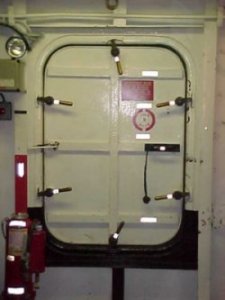 There are numerous types of doors: on deck,
some appear to be a heavy safe like doors with numerous
latching dogs around it’s perimeter. Pictured left
and below are some good examples.
There are numerous types of doors: on deck,
some appear to be a heavy safe like doors with numerous
latching dogs around it’s perimeter. Pictured left
and below are some good examples.
Below the waterline, the door are
generally of the sliding type; horizontal or vertical.
Maintenance of the doors should
consist of testing it’s full operation, and visual
check of operating mechanisms. Hoses and connections
checked for chaffing and tightness. Guides should be
clear of obstructions and greased. Wear surfaces should
be checked to to make sure they are secured and not worn
beyond tolerances. The hydraulic ram should be checked
for leaks, these can be caused by a damaged cylinder ram.
Manual pumps for the door should get a good "once
over" checking the fluid level, lever and it's
eccentrics for looseness. Check for leaks at the piping
joints.
The hydraulic power pack: Checks
include things such as hoses, fluid levels, loose wiring.
Check piping for leaks. Some
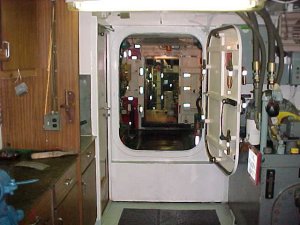 power packs have pressure reservoirs so that
doors can be actuated with a power failure. These
reservoirs store hydraulic energy by compressing nitrogen
at high pressure, these can be particularly prone to
leakage.
power packs have pressure reservoirs so that
doors can be actuated with a power failure. These
reservoirs store hydraulic energy by compressing nitrogen
at high pressure, these can be particularly prone to
leakage.
Additionally the controls for the
powerpack should be checked. Start and stop buttons,
remotes start and stop buttons should be checked for
operation with no binding. Horns are annoying and can
sometimes be found to be "un-operational".
Warning lights, if equipped, should be working. Contact
switches should be checked for operation and proper
setting.
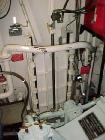
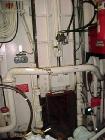 The above,
are pictures of a vertical sliding watertight
door. It is to access the shaft tunnel. Below are
pictures of a horizontal sliding type.
The above,
are pictures of a vertical sliding watertight
door. It is to access the shaft tunnel. Below are
pictures of a horizontal sliding type.
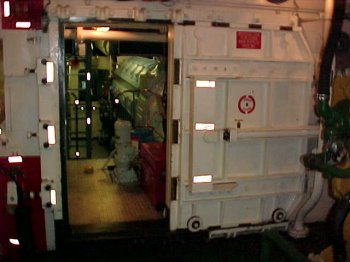
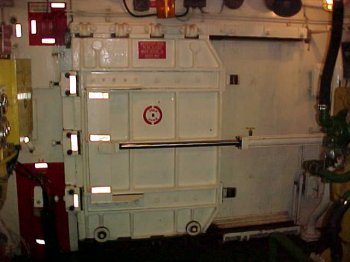
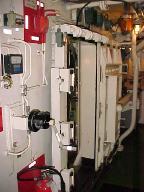 The pictures above and to the right are of
a sliding type door. By clicking on the picture to the
right you can clearly see the various points discussed
above. The manual operation crank in the foreground and
the control buttons, the grey box above the hand crank,
are clearly visible. The micro switch is at the top
corner of the door's frame. The yellow rotating light can
be seen in the upper right of the picture. Incidentally,
this picture serves to illustrate the fire pull
station as well as the fire extinguisher conveniently
located.
The pictures above and to the right are of
a sliding type door. By clicking on the picture to the
right you can clearly see the various points discussed
above. The manual operation crank in the foreground and
the control buttons, the grey box above the hand crank,
are clearly visible. The micro switch is at the top
corner of the door's frame. The yellow rotating light can
be seen in the upper right of the picture. Incidentally,
this picture serves to illustrate the fire pull
station as well as the fire extinguisher conveniently
located.
Manually operated door: Manually
actuated doors will generally have gears and long shafts
and chain drives. This is to allow operation from deck
level. If these are neglected, they could quickly lead to
some difficulties operating the door. Extra care should
be taken to maintain these components by cleaning,
greasing, and operating them.
There are numerous types of doors: on deck, some appear to be a heavy safe like doors with numerous latching dogs around it’s perimeter. Pictured left and below are some good examples.
power packs have pressure reservoirs so that doors can be actuated with a power failure. These reservoirs store hydraulic energy by compressing nitrogen at high pressure, these can be particularly prone to leakage.


The pictures above and to the right are of a sliding type door. By clicking on the picture to the right you can clearly see the various points discussed above. The manual operation crank in the foreground and the control buttons, the grey box above the hand crank, are clearly visible. The micro switch is at the top corner of the door's frame. The yellow rotating light can be seen in the upper right of the picture. Incidentally, this picture serves to illustrate the fire pull station as well as the fire extinguisher conveniently located.



Stainless steel cleaning services
ReplyDeletePickling and Passivation
Acid Pickling Passivation
Looking for Passivation services and Steel cleaning services and Pickling and Passivation wants proper services then we are here to help you right away and provides best services.